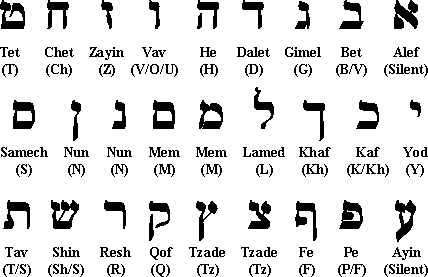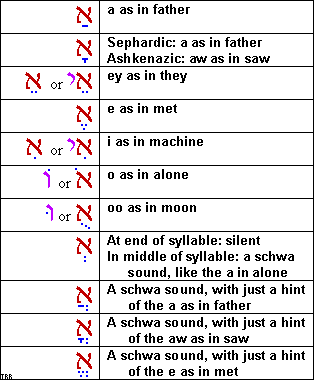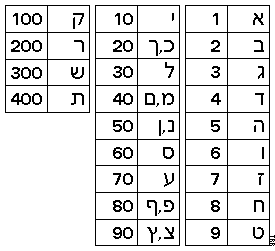About Gematria and Hebrew Characters and Numeric Values
|
|
Hebrew Alphabet
Level: Basic
The Hebrew and Yiddish languages use a different alphabet
than English. The picture below illustrates the Hebrew
alphabet, in Hebrew alphabetical order. Note that Hebrew
is written from right to left, rather than left to right
as in English, so Alef is the first letter of the Hebrew
alphabet and Tav is the last. The Hebrew alphabet is often
called the "alefbet," because of its first two letters.
Letters of the Alefbet
|

|
If you are familiar with
Greek, you will no doubt notice substantial similarities
in letter names and in the order of the alphabet.
The "Kh" and the "Ch" are pronounced as in German or
Scottish, a throat clearing noise, not as the "ch" in
"chair."
Note that there are two versions of some letters. Kaf, Mem,
Nun, Pe and Tzade all are written differently when they
appear at the end of a word than when they appear in the
beginning or middle of the word. The version used at the
end of a word is referred to as Final Kaf, Final Mem, etc.
The version of the letter on the left is the final
version. In all cases except Final Mem, the final version
has a long tail.
Vowels and Points
Like most early Semitic alphabetic writing systems, the
alefbet has no vowels. People who are fluent in the
language do not need vowels to read Hebrew, and most
things written in Hebrew in Israel are written without
vowels.
However, as Hebrew literacy declined, particularly after
the Romans expelled the Jews from Israel, the rabbis
recognized the need for aids to pronunciation, so they
developed a system of dots and dashes called nikkud
(points). These dots and dashes are written above, below
or inside the letter, in ways that do not alter the
spacing of the line. Text containing these markings is
referred to as "pointed" text.
|
Most nikkud are used to indicate vowels. The table
at right illustrates the vowel points, along with their
pronunciations. Pronunciations are approximate; I have
heard quite a bit of variation in vowel pronunciation.
Vowel points are shown in blue. The letter Alef, shown in
red, is used to illustrate the position of the points
relative to the consonents. The letters shown in purple
are technically consonents and would appear in unpointed
texts, but they function as vowels in this context.
|
 |
There are a few other nikkud, illustrated and explained
below.
|
 |
The dot that appears in the center of some letters is
called a dagesh. With most letters, the dagesh does
not significantly affect pronunciation. With the
letters Bet, Kaf and Pe, however, the dagesh indicates
that the letter should be pronounced with its hard
sound (the first sound) rather than the soft sound
(the second sound). In Ashkenazic pronunciation (the
pronunciation used by many Orthodox Jews and by older
Jews), Tav also has a soft sound, and is pronounced as
an "s" when it does not have a dagesh.
Vav, usually a consonant pronounced as a "v," is
sometimes a vowel pronounced "oo" (u) or "oh" (o).
When it is pronounced "oo", pointed texts have a
dagesh. When it is pronounced "oh", pointed texts have
a dot on top.
Shin is pronounced "sh" when it has a dot over the
right branch and "s" when it has a dot over the left
branch.
At right is an example of pointed text. Nikkud are
shown in blue. This line would be pronounced (in
Sephardic pronunciation, which is what most people use
today): V'ahavtah l'reyahkhah kamokhah. (And you shall
love your neighbor as yourself. Leviticus 19:18).
Styles of Writing
The style of writing illustrated above is the one most
commonly seen in Hebrew books. It is referred to as
block print or sometimes Assyrian text.
For sacred documents, such as torah scrolls or the
scrolls inside tefillin and mezuzot, there is a
special writing style with "crowns" (crows-foot-like
marks coming up from the upper points) on many of the
letters. This style of writing is known as STA"M (an
abbreviation for "Sifrei Torah, Tefillin and Mezuzot,"
which is where you will see that style of writing.
|
|
There is another style used for handwriting, in much
the same way that cursive is used for the Roman
(English) alphabet. This modern script style is
illustrated at right.
|
|
 |
 |
|
Another style is used in certain
texts to distinguish the body of the text from
commentary upon the text. This style is known as
Rashi Script, in honor of Rashi, the greatest
commentator on the Torah and the Talmud. The
alefbet at left is an example of Rashi Script.
|
|
Transliteration
The process of writing Hebrew words in the Roman (English)
alphabet is known as transliteration. Transliteration is
more an art than a science, and opinions on the correct
way to transliterate words vary widely. This is why the
Jewish festival of lights (in Hebrew, Chet-Nun-Kaf-He) is
spelled Chanukah, Chanukkah, Hanuka, and many other
interesting ways. Each spelling has a legitimate phonetic
and orthographic basis; none is right or wrong.
Numerical Values
|
 |
Each letter in the alefbet has a
numerical value. These values can be used to write
numbers, as the Romans used some of their letters (I,
V, X, L, C, M) to represent numbers. Alef through Yod
have the values 1 through 10. Yod through Qof have the
values 10 through 100, counting by 10s. Qof through
Tav have the values 100 through 400, counting by 100s.
Final letters have the same value as their non-final
counterparts.
|
|
The number 11 would be rendered Yod-Alef, the number 12 would be Yod-Bet, the
number 21 would be Kaf-Alef, the word Torah (Tav-Vav-Resh-He) has the numerical
value 611, etc. The only significant oddity in this pattern is the numbers 15
and 16, which if rendered as 10+5 or 10+6 would be a name of G-d, so they are
normally written Tet-Vav (9+6) and Tet-Zayin (9+7). The order of the letters is
irrelevant to their value; letters are simply added to determine the total
numerical value. The number 11 could be written as Yod-Alef, Alef-Yod, Heh-Vav,
Dalet-Dalet-Gimmel or many other combinations of letters.
Because of this system of assigning numerical values to letters, every word has
a numerical value. There is an entire discipline of Jewish mysticism known as
Gematria that is devoted to finding hidden meanings in the numerical values of
words. For example, the number 18 is very significant, because it is the
numerical value of the word Chai, meaning life. Donations to Jewish charities
are routinely made in denominations of 18 for that reason.
I have received several e-mails pointing out that the numerical value of Vav
(often transliterated as W) is 6, and therefore WWW has the numerical value of
666! It's an amusing notion, but Hebrew numbers just don't work that way. In
Hebrew numerals, the position of the letter/digit is irrelevant; the letters are
simply added up to determine the value. To say that Vav-Vav-Vav is six hundred
and sixty-six would be like saying that the Roman numeral III is one hundred and
eleven. The numerical value of Vav-Vav-Vav in Hebrew would be 6+6+6=18, so WWW
is equivalent to life! (It is also worth noting that the significance of the
number 666 is a part of Christian numerology, and has no basis that I know of in
Jewish thought).
|
|
Article by: Tracey R Rich
|
|